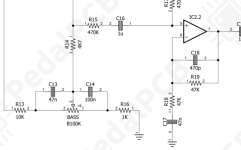Please bear with me, I’ve been building pedals for a few years but i’m a noob at understanding and tinkering with the circuits. I apologize if these particular EQ circuits have been discussed elsewhere, i’m sure they have. I’ve been searching and just not quite able to wrap my head around them.
Anyway, to the point. I built a pathogen and also breadboarded one to tinker with and see what i could get out of it.
So far, i’ve replaced the hard clipping diodes (D1 and D2) with a red LED and a blue LED. I’ve also replaced one of the soft clipping diodes (D4) with a blue LED. Finally i changed R22 to a 100k resistor to bring the overall output level down some, as using the LEDs made it insanely loud.
It sounds pretty good!! those small changes are subtle but fun. I used the blue LEDs as that was what i had laying around, but i’m relatively pleased with the result. My trouble is i lost a LOT of bass and the mid character has changed quite a but. If i max the bass knob out its still on par with the original circuit maxed out, it just drops off super early without any real adjustable area. The mids knob works but seems to have less range (even if i do turn down the bass knob). Overall it sounds pretty scooped and i’d like to try to get some mids back if i can.
So i guess my questions are… did changing R22 make me lose some of the make up gain for the EQ section, thus making the mids and bass more static? Or did changing to LEDs affect the tone that much that now the EQ section needs a rework? I played with the tonestack calculator online using the James dual bass capacitor passive circuit (which seems pretty similar) but using the values from the pathogen it seems like the bass already goes almost all the way to 0db and changing anything more seems like its going to mess with the treble and the mids even more.
Sorry for the wordy post if i’m unclear with what i’m asking i can try to explain it better.
if i’m unclear with what i’m asking i can try to explain it better.
Anyway, to the point. I built a pathogen and also breadboarded one to tinker with and see what i could get out of it.
So far, i’ve replaced the hard clipping diodes (D1 and D2) with a red LED and a blue LED. I’ve also replaced one of the soft clipping diodes (D4) with a blue LED. Finally i changed R22 to a 100k resistor to bring the overall output level down some, as using the LEDs made it insanely loud.
It sounds pretty good!! those small changes are subtle but fun. I used the blue LEDs as that was what i had laying around, but i’m relatively pleased with the result. My trouble is i lost a LOT of bass and the mid character has changed quite a but. If i max the bass knob out its still on par with the original circuit maxed out, it just drops off super early without any real adjustable area. The mids knob works but seems to have less range (even if i do turn down the bass knob). Overall it sounds pretty scooped and i’d like to try to get some mids back if i can.
So i guess my questions are… did changing R22 make me lose some of the make up gain for the EQ section, thus making the mids and bass more static? Or did changing to LEDs affect the tone that much that now the EQ section needs a rework? I played with the tonestack calculator online using the James dual bass capacitor passive circuit (which seems pretty similar) but using the values from the pathogen it seems like the bass already goes almost all the way to 0db and changing anything more seems like its going to mess with the treble and the mids even more.
Sorry for the wordy post



